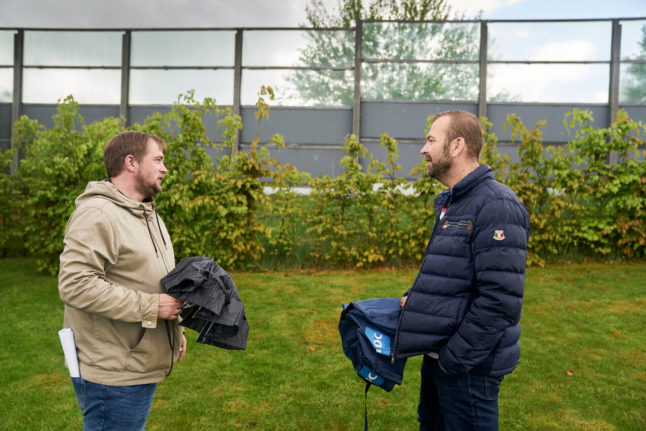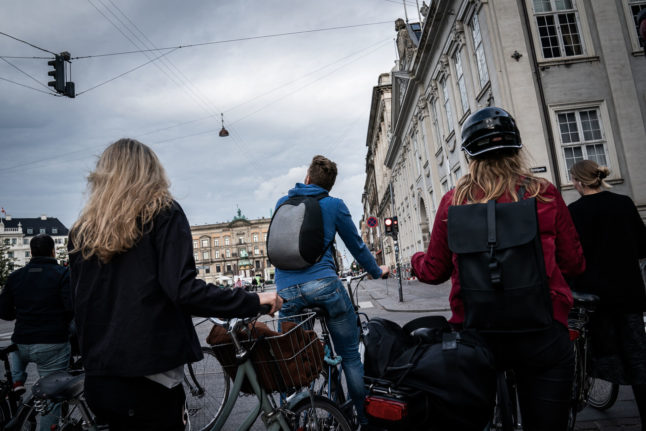Who would have thought that saying ‘hi’ could be complicated? Danes, however, are famously reserved, and will do much to avoid mumbling an awkward hej to a neighbour in the stairwell.
There are situations other than apartment buildings where you might pass a stranger in close proximity though, and sometimes people actually do say hello. So what are the conventions, if there are any at all? Here are some general guidelines.
READ ALSO: When can you talk to a stranger in Denmark without annoying them?
Are you in a small town or a big city?
If you’re in a small town, on a remote walking path, you could definitely greet anyone you meet, although a quick ‘hej’ is probably enough. No need to start making small talk about the weather.
Sometimes it can be difficult to know where to draw the greet/don’t greet line here, but if you’re engaging in some sort of leisure activity, like going for a walk or foraging in the forests, you should say ‘hi’ — unless, that is, there is such a high flow of people that you’d be saying ‘hi’ more than once every five minutes.
It’s also a good idea to say ‘hi’ to people you walk past if you’re in a town small enough for you to be easily identified as an outsider, in order to dispel any suspicions that you’re up to no good.
If you’re in a larger town, or any other sort of area where you’re likely to be walking past other human beings with any sort of regularity, you’re probably alright just giving a slight smile and nod if you end up making eye contact.
If someone says ‘hi’ to you, though, you should always say ‘hi’ back.
Will you be forced to continue chatting?
In Denmark, small talk is not as common and people generally prefer to have meaningful conversations about topics they are interested in.
Danes can also be more reserved around people they are not familiar with and shy away from asking personal questions until they know them better.
So, if you try making small talk at a bus stop and it falls flat, don’t take it personally. It’s just not the done thing in Denmark.
Are they busy?
Generally, Danes are more likely to say hej when they’re not busy or thinking about something else at the same time. They may stop to say hej on a weekend shopping trip or when out walking their dog, but ignore you by pretending to stare at their phone if they’re rushing to school or preschool pickup.
For example, it’s probably easier to say hej to a parent from your child’s kindergarten if you meet them at the weekend than it is if you see them at the gate of the kindergarten on a Tuesday morning — a more probably place to encounter each other.
READ ALSO: Six mistakes everyone makes when they first move to Denmark
Is it some sort of public holiday?
Similar to the point above, if it’s some sort of public holiday, like Easter, Christmas or Midsummer, and you happen to be out for a walk anywhere other than in a busy city or town centre, you could say hej to anyone you walk past, as well as the appropriate seasonal greeting for the holiday in question.
This is presumably due in part to the fact that Danes have a very clear boundary between work and private life, therefore assuming that everyone is off work over the holidays and isn’t too busy to say hello.
Even so, if you make no attempt to greet someone you pass during a public holiday, it won’t be poorly received. Danes tend to respect others’ choice to keep themselves to themselves. On the flip side, if you say hej and get no response, it’s not meant as a personal rejection.
Do you have a shared activity in common?
If you are going to be in the same place for more than a couple of minutes – you’re walking your dog at the same dog park, or your children are playing at the same playground, for example – then you should greet anyone else your path crosses with, if only to acknowledge their existence.
It’s probably overkill to actually go up to someone for the purpose of saying ‘hello’, but a quick greeting if you happen to be within speaking distance would be fine.
This also applies to things like gym classes or activities with some other sort of club or association, but not if you’re just waiting at the same bus stop.
Do you know this person (even vaguely)?
As a general rule, if you know someone even vaguely, you should greet them, although again, there are exceptions.
Usually, if you’re likely to see them again at some point in some other context, you should say hej. This could include a neighbour, a colleague, or a parent who often drops off or picks up their child from school or preschool at the same time as you.
One exception to this is if you see someone you used to know at some point who you haven’t seen in a while, like someone you went to school with or a former colleague.
This situation can be awkward as if you say hej, you almost have to start a longer conversation with them, which can be annoying if you or they are actually on their way to somewhere else.
You really have two options here: you can either choose to greet them if you think they have time to chat, or you can try and walk past without them spotting you if either of you are in a hurry. This sounds awkward, but it happens and I’ve personally been on either side of it.
What happens if I get it wrong?
Not much: as mentioned above, Danes don’t seem (in my impression) to be judgmental about people who are private. If you persistently ignore someone or are rude, it might be commented on. This could mean being asked directly why you don’t or didn’t say hello.
If, on the other hand, you greet people too often and force them to have painful small talk with you, they might complain that you are lidt for meget (a bit too much), although they would probably not say this to your face.
Let’s be honest, though, most people will just say hej back.



 Please whitelist us to continue reading.
Please whitelist us to continue reading.
Member comments